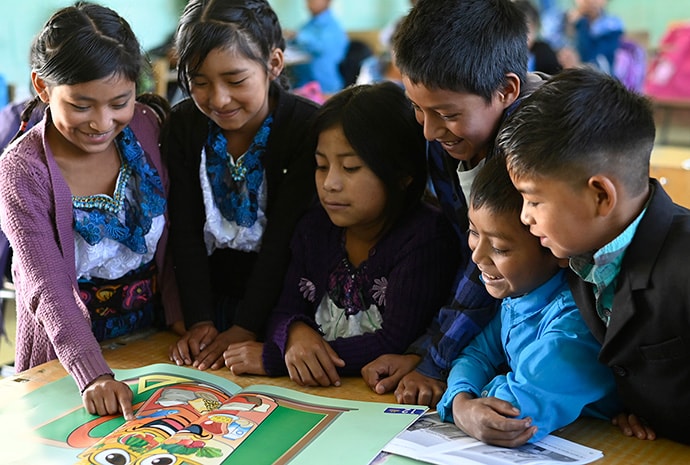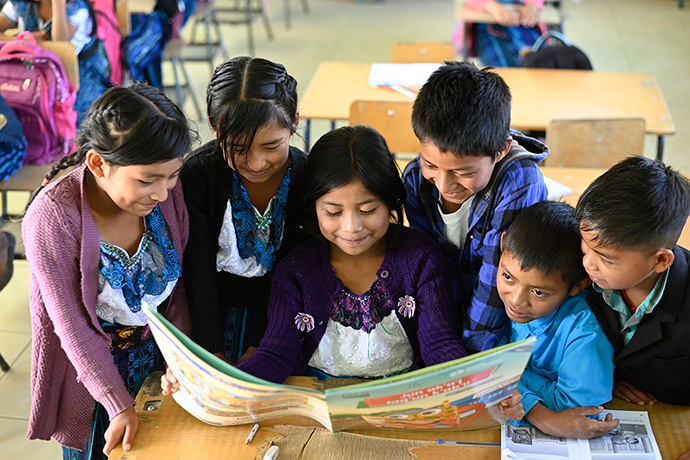By Leonel Arguello, Director of Integrated School Feeding Programs, Global Communities

Guatemalan children taking part of the Global Communities UNIDOS program. Photo: Global Communities
As a Nicaraguan, I grew up in a multiethnic, multicultural and multilingual country with a large Indigenous population. English and French were the mandatory languages in public and private schools during my school years. Sadly, we were never taught our Indigenous languages, not even simple phrases like “good morning” or “thank you.”
Linguistic discrimination is still prevalent in classrooms across Central America. Our native languages are disappearing, causing us to lose an integral part of our national heritage. Every 14 days, one of the 7,000 known languages spoken worldwide dies. By the end of this century, half of these languages will disappear.
Language bias also has negative impacts on children’s development. Numerous studies indicate that students not educated in their native languages tend to have lower learning outcomes than those who receive instruction in their mother tongues. Conversely, using a well-mastered language significantly enhances learning, particularly reading comprehension. Bilingual education also helps preserve cultural heritage and creates a bridge between the ancestral wisdom of Indigenous peoples and the global community of the 21st century, opening the doors to future opportunities within the Indigenous communities and beyond. Additionally, it contributes to community engagement in children’s education.
Global Communities, where I currently work, has been implementing the McGovern-Dole International Food for Education and Child Nutrition (MGD) programs across Central America and Africa for over 20 years. Our programs, funded by the United States Department of Agriculture (USDA), provide daily nutritious meals to school-age children and take a multidisciplinary approach to improve students’ nutritional and learning outcomes. Where feasible, they integrate bilingual education to ensure that children learn to read and write effectively.
In Guatemala, for example, where 25 Indigenous languages are spoken, our UNIDOS (“United” in Spanish) project has been a beacon of hope since 2021. Implemented across 450 preschools and primary schools in the departments of Huehuetenango and Quiche, UNIDOS supports students with daily meals, school supplies and educational materials available in local languages. In addition, the program works tirelessly to strengthen teachers’ bilingual skills and provide children with literacy skills in Spanish, Mam, Q’anjob’al, Ixil and K’iche’.
Learning in a native tongue is a source of pride for children and a daily affirmation of their cultural roots. It is an investment in the leaders of tomorrow, a commitment to cultural preservation and a statement that diversity is our strength. We must champion bilingual education as a vital part of our journey towards a more inclusive and understanding world.
In February 2024, UNIDOS conducted a study on students’ bilingual language skills. Overall, 80% of students reported using primarily the local Mayan language in their family interactions. The study also found that the use of both Spanish and Mayan languages in the classroom was positive for the achievement of biliteracy.

Guatemalan children taking part of the Global Communities UNIDOS program. Photo: Global Communities
UNIDOS is deeply committed to enhancing the teaching of foundational literacy skills, starting with the mother tongue and then transferring these skills to Spanish. It is crucial to support teachers in using both languages in their classrooms and improve parents’ involvement in their children’s learning. Additionally, the project implements social communication activities to inform parents and communities about the benefits of bilingual education.
On the last note, yes, I have learned the essential words in Miskito and Mayagna – two of my Indigenous languages – and promoted the learning of others to fulfill my personal and professional commitments.